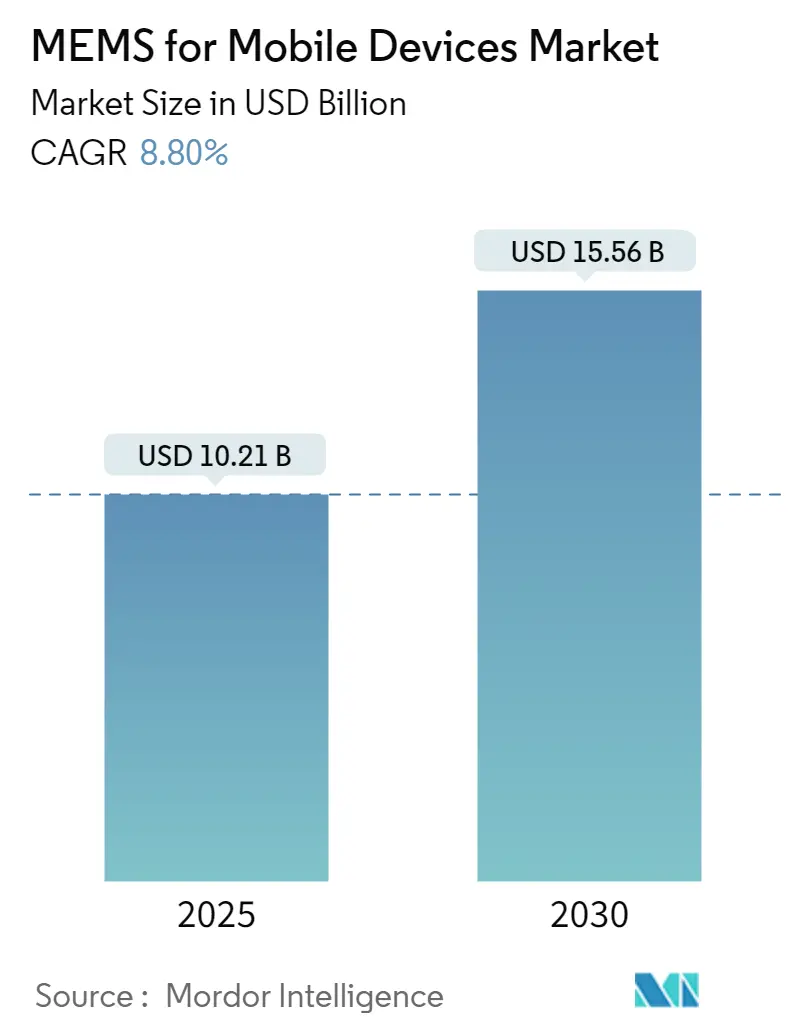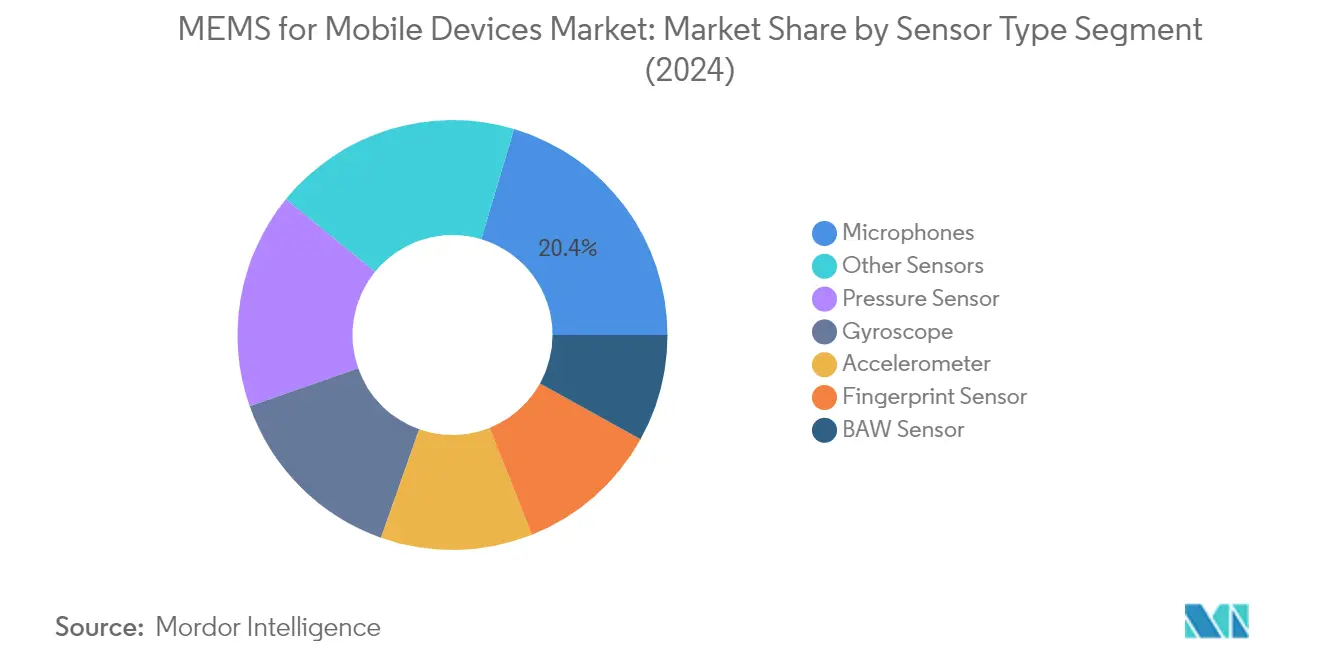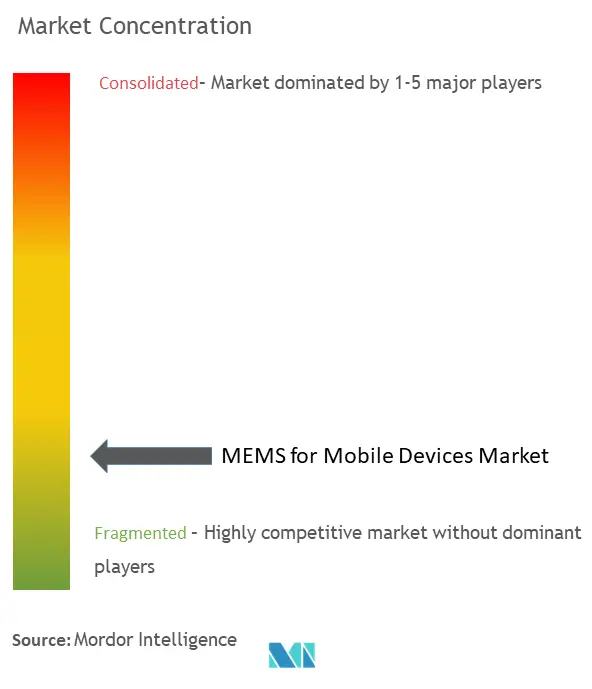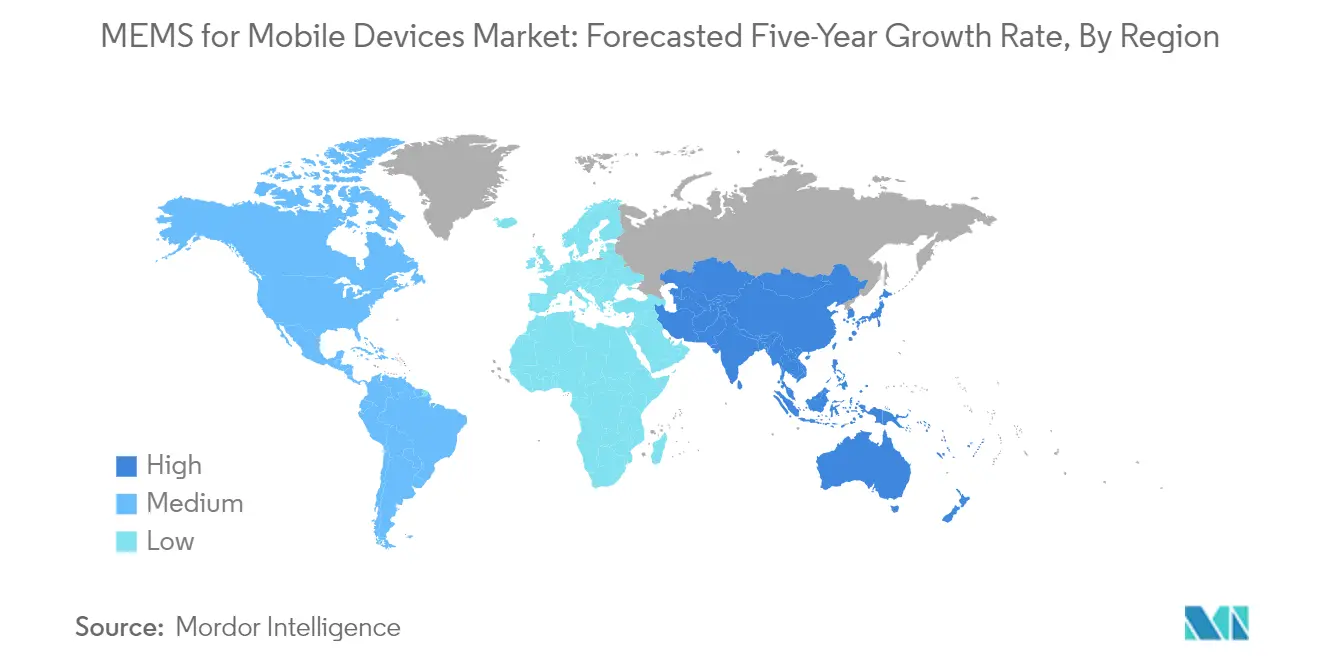
MEMS for Mobile Devices Market Analysis
The MEMS for Mobile Devices Market size is estimated at USD 10.21 billion in 2025, and is expected to reach USD 15.56 billion by 2030, at a CAGR of 8.8% during the forecast period (2025-2030).
The MEMS for mobile devices industry is experiencing significant transformation driven by the rapid advancement of 5G technology and increasing mobile connectivity. According to Ericsson forecasts, global mobile subscriptions reached approximately 8.4 billion in 2022, with 5G subscriptions projected to reach 5 billion by 2028. The deployment of 5G networks is expected to cover 85% of the global population, with these networks handling approximately 70% of mobile traffic. This technological shift is creating substantial demand for RF MEMS and sophisticated filtering solutions, particularly as devices need to support an expanding number of frequency bands.
The industry is witnessing remarkable innovations in mobile sensor technology and implementation. In January 2023, TDK Corporation introduced the InvenSense T5838 and T5837 MEMS microphones, featuring the world's lowest power Pulse Density Modulation with a high acoustic overload point of 133 dB SPL and an enhanced signal-to-noise ratio of 68 dBA. These advancements are complemented by developments in optical technology, as demonstrated by LG Innotek's introduction of their new optical telephoto zoom camera module featuring advanced optical image stabilization capabilities.
The market is experiencing a significant shift toward enhanced imaging and audio capabilities in mobile devices. The integration of optical image stabilization (OIS) and electronic image stabilization (EIS) enabled by smartphone sensor technology is becoming increasingly prevalent in smartphone applications. This trend is further evidenced by recent developments such as Akoustis Technologies' receipt of a high-volume 5G mobile filter purchase order in January 2023, highlighting the growing demand for advanced RF filtering solutions in mobile devices.
The industry is adapting to evolving consumer preferences, particularly in power management and device optimization. Manufacturers are focusing on developing smartphone MEMS devices with reduced power consumption while maintaining high-performance capabilities. This trend is particularly evident in China's mobile market, where 5G phone shipments reached 19.52 million in October 2022, accounting for 80.1% of the country's total mobile phone shipments. These developments reflect the industry's response to consumer demands for devices that offer advanced capabilities while maintaining efficient power consumption and optimal charging characteristics.
MEMS for Mobile Devices Market Trends
Increasing Acceptance of Miniaturization Trend
The miniaturization of devices has emerged as a crucial factor driving the demand for MEMS in mobile devices, as manufacturers continuously seek ways to reduce component sizes while maintaining or improving functionality. Modern smartphones now incorporate multiple sensors, including proximity sensors, accelerometers, gyroscopes, fingerprint sensors, ambient light sensors, compasses, Hall effect sensors, and barometers, creating an urgent need for smaller MEMS components to optimize device design. This trend is evidenced by innovations such as the SiT15xx MEMS oscillators, which are available in 1.5 x 0.8 x 0.55mm chip-scale packages, achieving an impressive 85% reduction in footprint compared to standard 2.0 x 1.2mm SMD XTAL packages. The development of these miniaturized components has enabled manufacturers to incorporate more features while maintaining compact device form factors.
The industry has witnessed significant advancements in MEMS miniaturization, particularly with the emergence of Nano Electromechanical Systems (NEMS)-based mobile accelerometer developments utilizing graphene technology. These innovative accelerometers occupy substantially smaller die areas compared to conventional silicon MEMS accelerometers while maintaining competitive sensitivity levels. In January 2023, TDK Corporation demonstrated this trend by introducing the InvenSense T5838 and T5837 MEMS microphones, which combine compact size with high-performance features such as a high acoustic overload point of 133 dB SPL and a signal-to-noise ratio of 68 dBA. The continuous push for miniaturization has also led to the development of next-generation micro-accelerometers with ultra-small dimensions and enhanced sensitivity, particularly crucial for applications where traditional sensors cannot efficiently operate.
Increasing Demand for High-Performance Devices
The growing demand for high-performance mobile devices has become a significant driver for MEMS sensor development, particularly as smartphones incorporate more sophisticated features and applications. The transition to 5G technology has created a need for advanced MEMS sensors that can support enhanced connectivity and performance requirements. This is exemplified by recent innovations such as Qualcomm's ultraBAW RF filter technology, designed to distinguish signals from 2.7 GHz to 7.2 GHz, enabling innovative 5G solutions. The demand for high-performance devices has also led to the development of sophisticated MEMS microphones for improved audio processing, with manufacturers now incorporating multiple microphones per device for enhanced features such as echo cancellation, noise reduction, and beam steering.
The industry has responded to this demand with continuous innovations in sensor technology and performance optimization. In January 2023, STMicroelectronics and Qualcomm Technologies formed a collaboration to develop advanced sensor subsystems for smart mobile devices, focusing on optimizing performance and battery efficiency. This partnership demonstrates the industry's commitment to meeting the increasing demands for high-performance capabilities while maintaining power efficiency. The trend is further evidenced by developments in optical image stabilization (OIS) and electronic image stabilization (EIS) technologies, which are increasingly being enabled by MEMS sensors to support advanced camera functionalities in smartphones. LG Innotek's introduction of a new optical telephoto zoom camera module in December 2022, featuring an optical image stabilizer to minimize blur in photos taken at longer focal lengths, exemplifies the industry's focus on high-performance applications. The integration of mobile gyroscope and mobile accelerometer technologies in these devices further enhances their performance, meeting the sophisticated demands of modern users.
Segment Analysis: By Type of Sensor
Microphones Segment in MEMS for Mobile Devices Market
The mobile device microphone segment dominates the MEMS for mobile devices market, holding approximately 20% market share in 2024. The segment's leadership position is driven by the increasing demand for better voice quality and enhanced audio experiences in mobile devices. Modern high-end smartphones are incorporating multiple mobile device microphones for improved audio processing capabilities. The growing adoption of smart voice assistant tools and advanced features like active noise cancellation has further augmented the demand for MEMS microphones. These microphones are specifically designed to deliver high-quality voice capture and superior acoustic performance while maintaining small package footprints. The segment's growth is also supported by the rising integration of voice control capabilities in smartphones and the expanding applications in areas like online meetings and health tracking features.

Fingerprint Sensor Segment in MEMS for Mobile Devices Market
The fingerprint sensor segment is emerging as the fastest-growing segment in the MEMS for mobile devices market, projected to grow at approximately 11% during 2024-2029. This rapid growth is attributed to the increasing emphasis on smartphone security and the superior authentication capabilities offered by fingerprint sensing technology. The segment's expansion is further driven by technological advancements in both optical and ultrasonic fingerprint sensors, enabling through-display fingerprint scanning capabilities in modern smartphones. The development of new techniques in fingerprint sensing, including the integration of capacitive and optical technologies, is enhancing the segment's growth potential. Manufacturers are continuously innovating to improve the accuracy, speed, and reliability of fingerprint sensors while reducing their form factor to accommodate the trending bezel-less smartphone designs.
Remaining Segments in MEMS for Mobile Devices Market
The other significant segments in the MEMS for mobile devices market include pressure sensors, mobile gyroscopes, mobile accelerometers, BAW sensors, and various other sensor types. Pressure sensors play a crucial role in altitude tracking and floor detection applications, while mobile gyroscopes and mobile accelerometers are essential for motion sensing, gaming, and image stabilization features. BAW sensors are particularly important for RF filtering in 5G smartphones. The remaining sensor types, including humidity, temperature, and proximity sensors, contribute to the overall functionality of mobile devices by enabling environmental sensing and user interaction features. Each of these segments continues to evolve with technological advancements, supporting the growing demand for more sophisticated and feature-rich mobile devices.
MEMS for Mobile Devices Market Geography Segment Analysis
MEMS for Mobile Devices Market in North America
North America holds a dominant position in the MEMS market for mobile devices, capturing approximately 21% of the global market share in 2024. The region's strength is due to its advanced technological infrastructure and early adoption of innovative mobile technologies. The presence of major MEMS manufacturers and sophisticated research facilities continues to drive market growth. The region's readiness to embrace new-age technologies and innovations in mobile devices significantly propels market expansion. The ecosystem of connected devices is flourishing in North America, particularly boosting the application of mobile sensor technologies in smartphones for navigation-based applications. The growing expansion of MEMS providers and their continuous focus on product innovation further stimulates market development. The deployment of 5G services across many parts of the region has elevated the importance of smartphone sensor technologies, as they play crucial roles in enabling advanced mobile functionalities and features.
MEMS for Mobile Devices Market in Europe
The European MEMS for mobile devices market has demonstrated robust growth, with an estimated growth rate of around 7% during 2019-2024. The region maintains a strong foundation in MEMS technology development, supported by advanced manufacturing capabilities and innovative research institutions. European smartphone manufacturers continue to incorporate increasingly sophisticated smartphone MEMS sensors that support various applications, from environmental monitoring to advanced gaming features. The smartphone is becoming more integral to the IoT ecosystem in the region, where smart city initiatives are growing and becoming critical drivers for the consumer electronics sector. The region's commitment to technological advancement is evident in the substantial investments in research and development facilities. European countries are actively promoting the development of next-generation mobile technologies, creating a favorable environment for MEMS sensor innovations. The presence of established semiconductor manufacturers and research institutions further strengthens the region's position in the global MEMS ecosystem.
MEMS for Mobile Devices Market in Asia-Pacific
The Asia-Pacific region stands as the powerhouse in the MEMS for mobile devices market, projected to grow at approximately 10% during 2024-2029. The region's dominance is attributed to its robust electronics manufacturing ecosystem and large customer base. The availability of raw materials, coupled with competitive establishment and labor costs, continues to attract companies to establish their production centers in the region. The rapid development of the telecom sector and the increasing investment in advanced mobile networks significantly drive market growth. Countries such as China, India, Japan, and South Korea are spearheading the adoption of advanced mobile technologies. The region's strong focus on technological innovation and manufacturing excellence has created a conducive environment for MEMS smartphone sensor development. The presence of major smartphone manufacturers and their continuous efforts to integrate advanced MEMS technologies further strengthens the market position.
MEMS for Mobile Devices Market in Latin America
The Latin American MEMS for mobile devices market demonstrates significant potential for growth, driven by increasing smartphone penetration and evolving consumer preferences. The region's market dynamics are shaped by the growing adoption of advanced mobile technologies and the expansion of digital infrastructure. Lower manufacturing costs are attracting global manufacturers to the region, especially those targeting finished product market opportunities in Europe and North America. The positive domestic production of consumer electronics, including smartphones, is driving the demand for MEMS-based mobile sensor technologies. The region is witnessing an increasing inflow of smartphone vendors and manufacturers, creating new opportunities for MEMS sensor applications. The growing emphasis on local manufacturing and assembly operations is expected to create a more robust ecosystem for MEMS devices. The region's young, tech-savvy population continues to drive demand for smartphones with advanced features, thereby stimulating the MEMS sensor market.
MEMS for Mobile Devices Market in Middle East & Africa
The Middle East & Africa region presents unique opportunities in the MEMS for mobile devices market, driven by high disposable income levels and increasing technological adoption. The region's substantial youth population, with their preference for gaming and advanced mobile features, creates a strong demand for MEMS-enabled smartphones. The rapid digital transformation across various countries in the region is fostering the adoption of advanced mobile technologies. The market is benefiting from increasing investments in telecommunications infrastructure and the growing penetration of smartphones. The region's focus on creating smart cities and digital ecosystems is driving the demand for advanced mobile devices with sophisticated MEMS sensors. The increasing presence of global smartphone manufacturers and their expanding distribution networks is enhancing market accessibility. The growing emphasis on local assembly and manufacturing operations is expected to create new opportunities for MEMS sensor applications in the region.
MEMS for Mobile Devices Industry Overview
Top Companies in MEMS for Mobile Devices Market
The market features established players like Analog Devices, Bosch Sensortec, STMicroelectronics, TDK (InvenSense), and Knowles Corporation leading product innovation and development. Companies are focusing on advancing their MEMS technology capabilities through increased R&D investments and the development of next-generation smartphone sensors optimized for mobile applications. Strategic partnerships with smartphone manufacturers and technology companies are becoming increasingly common to ensure product integration and market access. Operational excellence is being achieved through vertical integration of manufacturing processes and optimization of supply chains. Geographic expansion, particularly in Asia-Pacific markets, remains a key priority given the concentration of smartphone manufacturing in the region. Companies are also emphasizing miniaturization trends and power efficiency improvements while developing multi-sensor fusion capabilities to address evolving smartphone MEMS requirements.
Consolidated Market with Strong Regional Players
The MEMS for mobile devices market exhibits a relatively consolidated structure dominated by large multinational corporations with diverse technology portfolios. These major players typically operate as integrated device manufacturers with strong manufacturing capabilities and established relationships with leading smartphone brands. Regional players, particularly in Asia, have emerged as significant competitors by leveraging their proximity to major smartphone manufacturing hubs and developing specialized MEMS solutions. The market has witnessed strategic acquisitions aimed at expanding technology capabilities and market reach, with larger companies acquiring specialized MEMS manufacturers to strengthen their product portfolios.
The competitive dynamics are characterized by a mix of global conglomerates and specialized MEMS manufacturers, each bringing unique strengths to the market. Conglomerates leverage their broad technology expertise and financial resources to drive innovation, while specialists focus on developing cutting-edge MEMS solutions for specific applications. Market consolidation continues through strategic partnerships and joint ventures, particularly in emerging technology areas like sensor fusion and advanced MEMS applications. The industry's evolution is marked by increasing collaboration between MEMS manufacturers and smartphone OEMs to develop customized solutions.
Innovation and Integration Drive Market Success
Success in the MEMS mobile device market increasingly depends on companies' ability to innovate while maintaining cost competitiveness. Incumbent players must focus on developing advanced MEMS smartphone solutions that integrate multiple sensing capabilities while reducing power consumption and form factor. Strategic investments in research and development, coupled with strong intellectual property portfolios, are essential for maintaining market leadership. Companies need to establish robust relationships with smartphone manufacturers early in the design cycle and demonstrate the ability to scale production while maintaining quality standards. Additionally, vertical integration of key manufacturing processes and development of proprietary technologies help create competitive advantages.
Market contenders can gain ground by focusing on specialized MEMS applications and developing innovative solutions for emerging smartphone features. Success factors include building strong technological capabilities, establishing efficient manufacturing processes, and developing strategic partnerships with key industry players. Companies must navigate the high concentration of smartphone manufacturers while addressing potential substitution risks from alternative sensing technologies. The regulatory landscape, particularly regarding privacy and security requirements for sensor data, influences product development strategies. Successful players will need to balance innovation with standardization requirements while maintaining flexibility to adapt to rapidly evolving smartphone technology trends.
MEMS for Mobile Devices Market Leaders
-
Analog Devices Inc.
-
Bosch Sensortec GmbH
-
STMicroelectronics N.V.
-
InvenSense Inc. (TDK)
-
Goertek Inc.
- *Disclaimer: Major Players sorted in no particular order

MEMS for Mobile Devices Market News
- December 2022: Knowles introduced new balanced armatures and MEMS microphones for over-the-counter hearing aids. The new product released provides performance and design flexibility to help speed up the production of hearing health products. Three full-range balanced armature receivers and two updated MEMS microphones will meet the stringent design and acoustic performance requirements of hearing aids.
- November 2022: Bosch partnered with microsystems design house Hahn-Schickard to develop MEMS micro speakers for audio and voice-based applications. The collaboration with Hahn-Schickard allowed the company to expand its expertise in MEMS micro speakers to strengthen its market position as a top manufacturer of sensor solutions for consumer electronics and position it as a critical player for mobile and audio-based applications.
MEMS for Mobile Devices Market Report - Table of Contents
1. INTRODUCTION
- 1.1 Study Assumptions and Market Definition
- 1.2 Scope of the Study
2. RESEARCH METHODOLOGY
3. EXECUTIVE SUMMARY
4. MARKET INSIGHTS
- 4.1 Market Overview
-
4.2 Industry Attractiveness - Porter's Five Forces Analysis
- 4.2.1 Bargaining Power of Suppliers
- 4.2.2 Bargaining Power of Buyers
- 4.2.3 Threat of New Entrants
- 4.2.4 Threat of Substitutes Products
- 4.2.5 Intensity of Competitive Rivalry
- 4.3 Assessment of the Impact of COVID-19 on the Market
5. MARKET DYNAMICS
-
5.1 Market Drivers
- 5.1.1 Increasing Acceptance of Miniaturization Trend
- 5.1.2 Increasing Demand for High-Performance Devices
-
5.2 Market Restraints
- 5.2.1 Highly Complex Manufacturing Process and Demanding Cycle Time
- 5.2.2 Lack of Standardized Fabrication Process
6. MARKET SEGMENTATION
-
6.1 By Type of Sensor
- 6.1.1 Fingerprint Sensor
- 6.1.2 Accelerometer Sensor
- 6.1.3 Gyroscope
- 6.1.4 Pressure Sensor
- 6.1.5 BAW Sensor
- 6.1.6 Microphones
- 6.1.7 Other Types of Sensors
-
6.2 By Geography
- 6.2.1 North America
- 6.2.2 Europe
- 6.2.3 Asia-Pacific
- 6.2.4 Latin America
- 6.2.5 Middle-East and Africa
7. COMPETITIVE LANDSCAPE
-
7.1 Company Profiles
- 7.1.1 Analog Devices Inc.
- 7.1.2 Bosch Sensortec GmbH
- 7.1.3 STMicroelectronics NV
- 7.1.4 InvenSense Inc. (TDK)
- 7.1.5 Goertek Inc.
- 7.1.6 Knowles Corporation
- 7.1.7 Murata Manufacturing
- 7.1.8 AAC Technologies
- 7.1.9 MEMSIC Inc.
- 7.1.10 BSE Co. Ltd
- *List Not Exhaustive
8. INVESTMENT ANALYSIS
9. FUTURE OF THE MARKET
MEMS for Mobile Devices Industry Segmentation
MEMS technology refers to miniaturized mechanical and electro-mechanical elements, such as devices and structures, that are manufactured and fabricated using microfabrication techniques.MEMS devices can range in size from well below one micron to several millimeters.
The market size is evaluated by analyzing various types of sensors, such as fingerprint sensors, accelerometer sensors, gyroscopes, pressure sensors, BAW sensors, and microphones, in multiple geographies, including North America, Europe, Asia-Pacific, Latin America, and the Middle East and Africa. The market sizes and forecasts are provided in terms of value (USD million) for all the above segments.
| By Type of Sensor | Fingerprint Sensor |
| Accelerometer Sensor | |
| Gyroscope | |
| Pressure Sensor | |
| BAW Sensor | |
| Microphones | |
| Other Types of Sensors | |
| By Geography | North America |
| Europe | |
| Asia-Pacific | |
| Latin America | |
| Middle-East and Africa |
MEMS for Mobile Devices Market Research FAQs
How big is the MEMS for Mobile Devices Market?
The MEMS for Mobile Devices Market size is expected to reach USD 10.21 billion in 2025 and grow at a CAGR of 8.80% to reach USD 15.56 billion by 2030.
What is the current MEMS for Mobile Devices Market size?
In 2025, the MEMS for Mobile Devices Market size is expected to reach USD 10.21 billion.
Who are the key players in MEMS for Mobile Devices Market?
Analog Devices Inc., Bosch Sensortec GmbH, STMicroelectronics N.V., InvenSense Inc. (TDK) and Goertek Inc. are the major companies operating in the MEMS for Mobile Devices Market.
Which is the fastest growing region in MEMS for Mobile Devices Market?
Asia-Pacific is estimated to grow at the highest CAGR over the forecast period (2025-2030).
Which region has the biggest share in MEMS for Mobile Devices Market?
In 2025, the Asia-Pacific accounts for the largest market share in MEMS for Mobile Devices Market.
What years does this MEMS for Mobile Devices Market cover, and what was the market size in 2024?
In 2024, the MEMS for Mobile Devices Market size was estimated at USD 9.31 billion. The report covers the MEMS for Mobile Devices Market historical market size for years: 2019, 2020, 2021, 2022, 2023 and 2024. The report also forecasts the MEMS for Mobile Devices Market size for years: 2025, 2026, 2027, 2028, 2029 and 2030.
Our Best Selling Reports
MEMS for Mobile Devices Market Research
Mordor Intelligence provides a comprehensive analysis of the MEMS smartphone industry. We leverage our extensive expertise in tracking mobile sensor technologies and innovations. Our research thoroughly examines the evolution of smartphone sensors and MEMS motion sensors. This includes mobile gyroscopes, mobile accelerometers, and mobile device microphones that are revolutionizing modern devices. The report offers detailed insights into how smartphone MEMS technology is advancing the capabilities of contemporary mobile devices.
Our detailed report, available as an easy-to-download PDF, offers stakeholders crucial insights into the development and implementation of motion sensors in smartphones and other mobile devices. The analysis covers emerging technologies, regulatory frameworks, and innovation trends. This helps businesses make informed decisions about mobile sensor integration and development strategies. Industry participants gain valuable understanding of technological advancements, competitive dynamics, and growth opportunities in the MEMS ecosystem for mobile applications.




